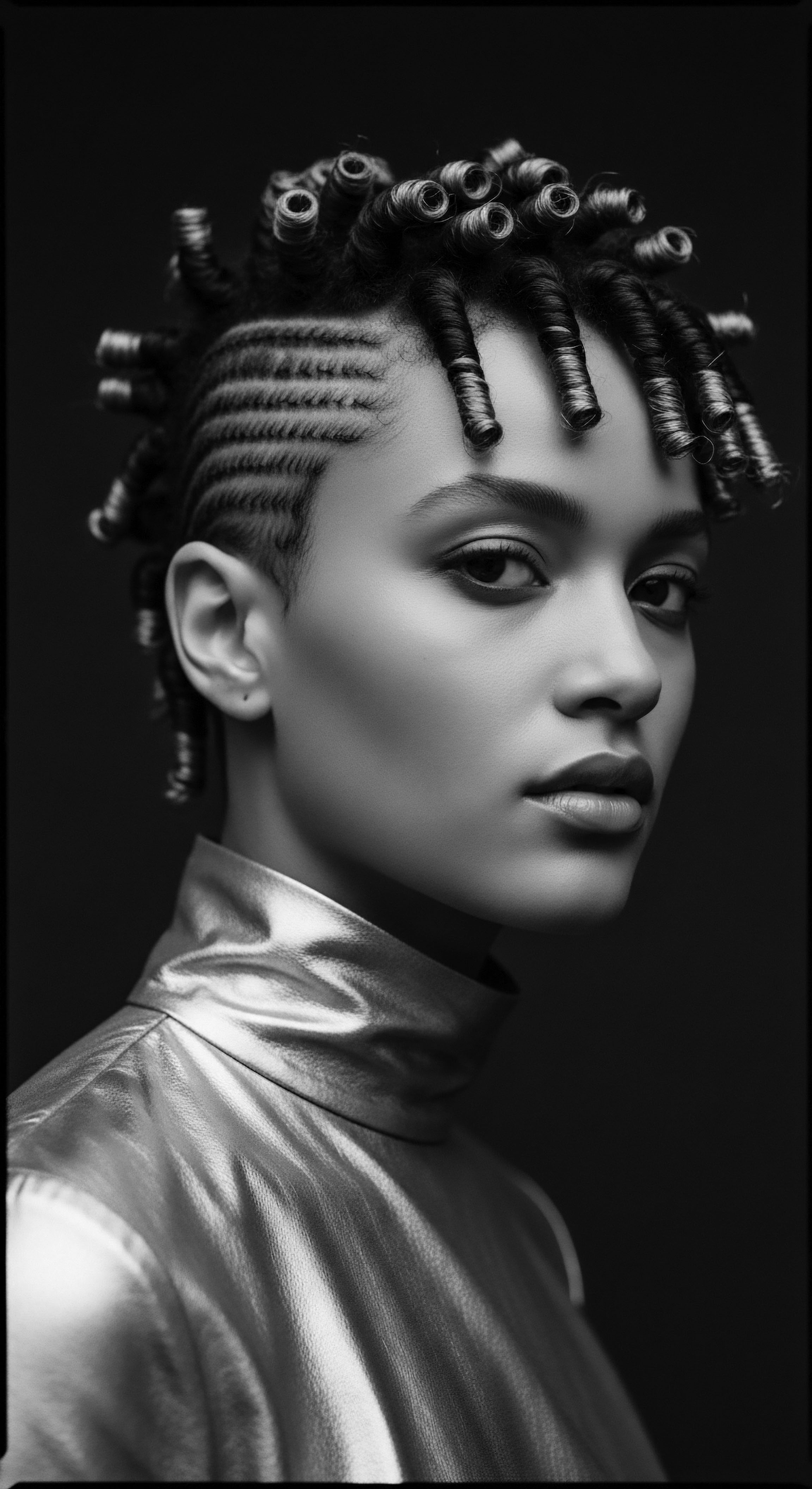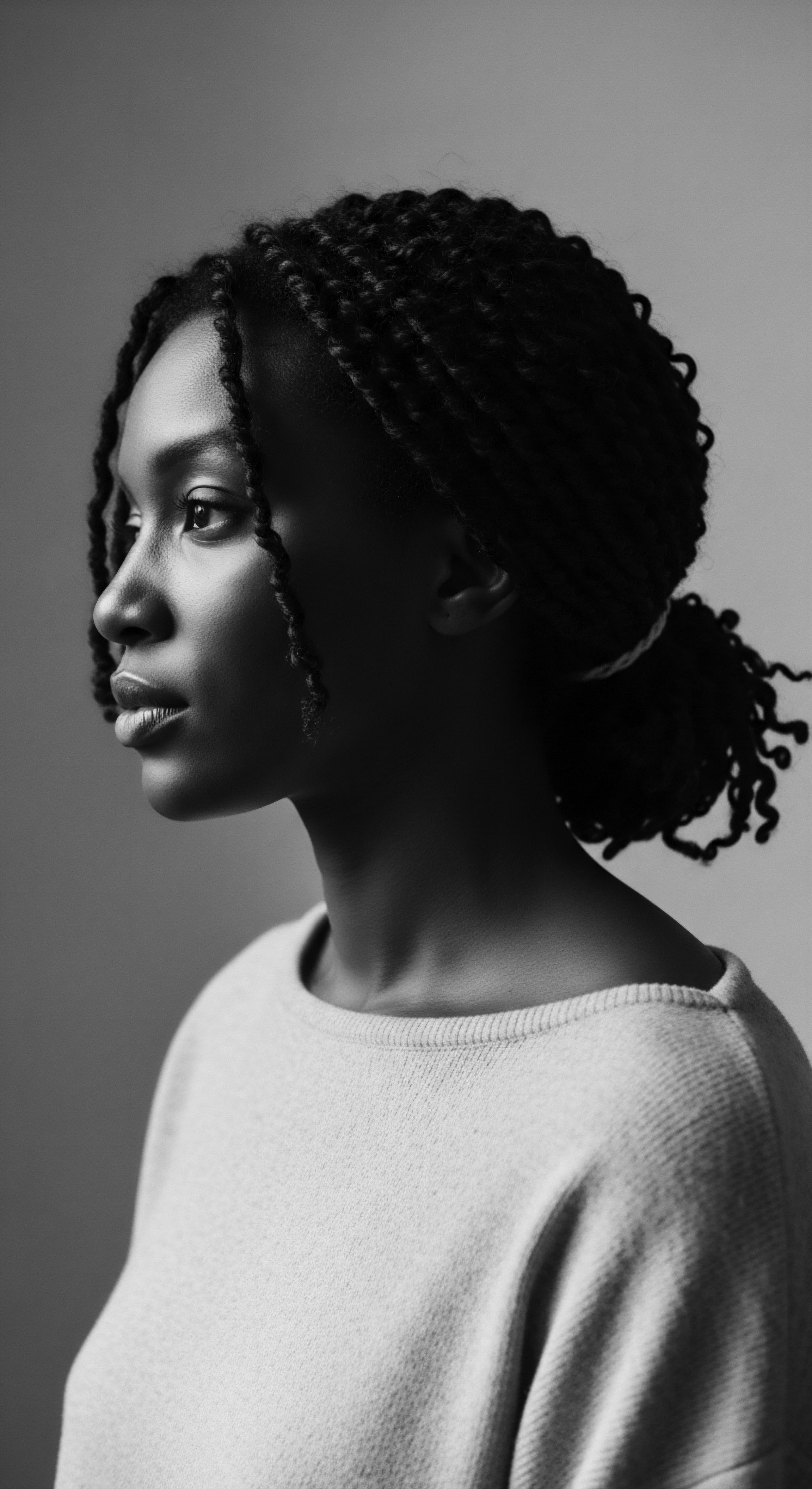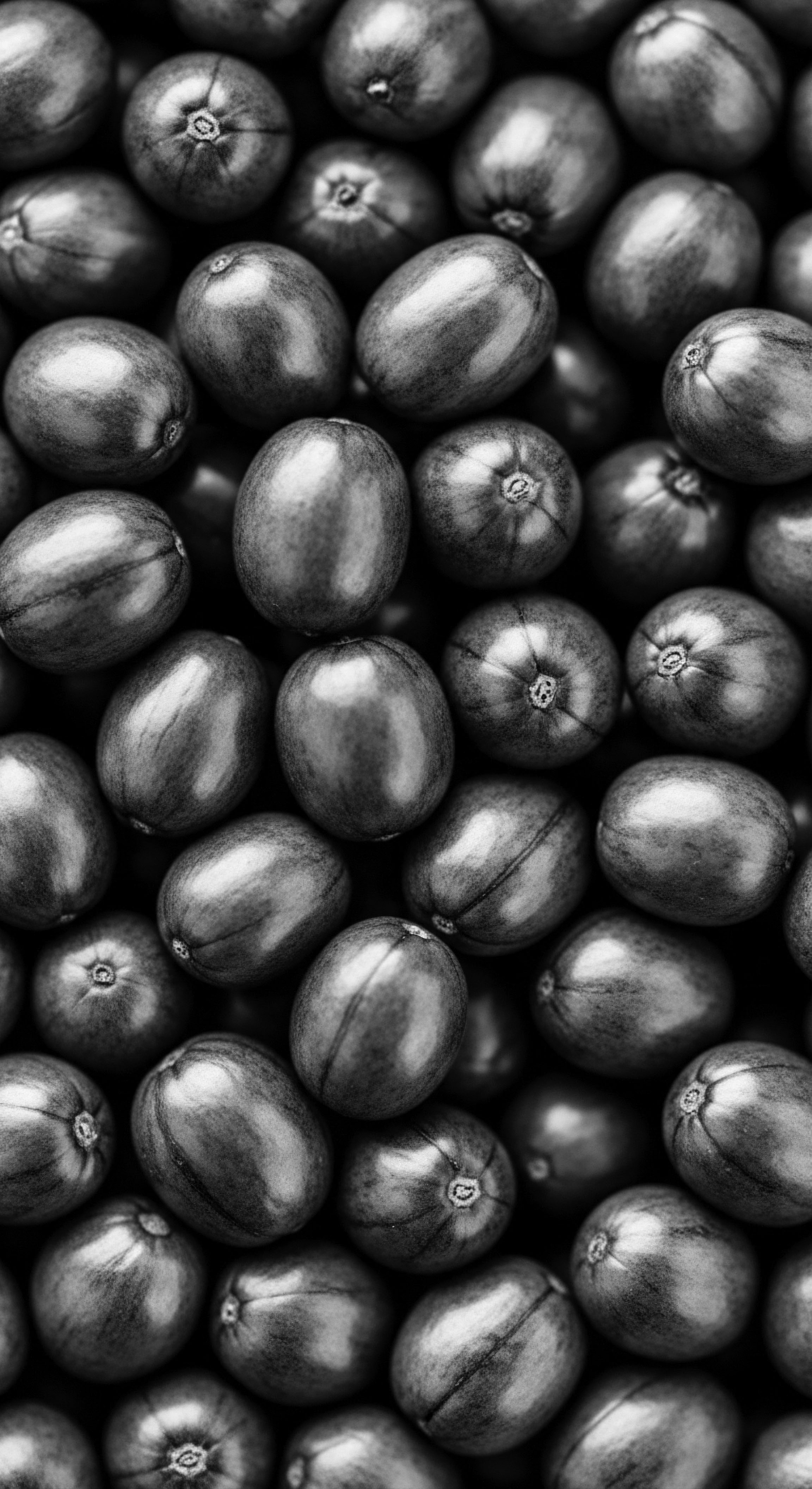
Roots
Consider for a moment the very strands that grace your crown. They are not merely protein filaments; they are living archives, each curl and coil holding a whispered history, a lineage spanning epochs and continents. For those with textured hair, this genetic inheritance connects us to ancestral lands, to rhythms of life lived in communion with the earth, and to ingenious practices born of necessity and wisdom. To truly grasp how ancestral foods lend their support to the flourishing of textured hair, one must first listen to these echoes from the source, understanding hair beyond its superficial guise, placing it within its broader biological and cultural story.
The architecture of textured hair, so distinct in its helical form, dictates its unique needs. Unlike straighter patterns, the elliptical shape of the hair follicle creates a strand that twists upon itself as it grows. These turns and bends, while undeniably beautiful, also present inherent characteristics ❉ a tendency towards dryness as natural sebum struggles to travel down the spiraling shaft, and a propensity for fragility at each curve where the cuticle layers might lift.
From time immemorial, our forebears understood these characteristics not through microscopes, but through observation, through touch, and through the undeniable resilience of their own tresses. Their understanding was empirical, rooted in generations of lived experience and collective wisdom.

Anatomy’s Ancestral Whispers
The very biology of hair, the constant cycle of growth, rest, and renewal, is a testament to the body’s innate wisdom, a wisdom often augmented by what the earth provides. Hair, at its cellular core, requires specific building blocks—amino acids, vitamins, and minerals—to construct keratin, the fibrous protein that forms the hair shaft. Ancestral diets, rich in diverse, unprocessed foods, naturally delivered these vital components.
The helical structure of textured hair, though presenting unique care considerations, is a testament to biological adaptation and enduring beauty.
Long before laboratories could quantify amino acid profiles, ancestral communities recognized the tangible results of a well-nourished body reflected in strong, vibrant hair. The strength of the hair shaft, its elasticity, and its inherent protection from environmental elements were all, in part, a silent declaration of the body’s internal state. When the body received sustenance from nutrient-dense, culturally significant foods, the hair responded in kind.

Tracing Hair Types Through Heritage
While contemporary systems classify textured hair into numerical and alphabetical types, the language of our ancestors often described hair through its visual appearance, its feel, its cultural significance, or even its perceived lineage. These descriptions were not merely aesthetic; they were often tied to social status, ceremonial rites, and collective identity. The variance in curl patterns across the African diaspora, for instance, speaks to the immense genetic diversity inherent to the continent, each curl a testament to millennia of adaptation and human migration.
Understanding the physical attributes of various curl patterns also means understanding their needs. A tighter coil, for example, typically experiences more shrinkage, giving the appearance of less length than it truly possesses. This inherent characteristic demands specific attention to moisture retention, a practice ingrained in ancestral hair care methods that relied heavily on plant-based oils and butters derived from indigenous flora.

The Living Language of Hair
The lexicon surrounding textured hair today carries echoes of historical practices and colonial influences. Yet, within many communities, traditional terms persisted, describing not only hair types but also the plants, the rituals, and the communal acts of care.
Consider the historical usage of ingredients, often tied to their local availability and the specific nutritional needs they met.
- Shea Butter ❉ A staple across West Africa, derived from the nuts of the shea tree, provided a profound source of moisture and protective fatty acids for both skin and hair.
- Castor Oil ❉ Widely used in ancient Egypt and other African cultures, extracted from castor beans, was prized for its reputed ability to strengthen strands and promote growth (Katherine, 2025). Its thick viscosity made it ideal for sealing in moisture.
- Moringa ❉ Often called the “miracle tree” in many African regions, its leaves and seeds offer a wealth of vitamins and minerals, whether consumed as food or applied topically as an oil, contributing to overall well-being reflected in hair vibrancy.

Cycles of Growth, Echoes of Sustenance
Hair growth follows distinct phases ❉ anagen (growth), catagen (transition), and telogen (rest). The duration of the anagen phase significantly dictates how long hair can grow. While genetics play a substantial role here, nutrition acts as a critical modulating factor. A body lacking essential nutrients cannot sustain optimal hair follicle activity, leading to weaker strands, increased shedding, or slower growth.
From a historical perspective, communities often adapted their foodways to seasonal changes and resource availability. The ability to preserve foods, whether through drying, fermentation, or other means, ensured a consistent supply of nutrients, even when fresh produce was scarce. This foresight in food preservation implicitly supported continuous bodily functions, including healthy hair regeneration. The interplay between consistent, wholesome nourishment and the natural rhythm of hair’s life cycle was a truth known to those who lived closely with the land.
The understanding of hair’s fundamental needs, though expressed differently through the ages, always circled back to the well-being of the entire person, a truth ancestors understood intrinsically.

Ritual
Beyond the elemental biology of hair, the very act of its care has always been imbued with ritual. For textured hair, especially within Black and mixed-race communities, these rituals became more than routines; they evolved into acts of cultural preservation, of intergenerational teaching, and of defiance against imposed beauty standards. Ancestral foods, prepared for consumption, frequently found their way into these very hair rituals, blurring the lines between internal sustenance and external application. The ingredients that nourished the body were often the very ones anointed upon the scalp and strands.
The careful selection of ingredients, often gathered from the local environment, speaks to a profound ecological wisdom. These were not random choices, but rather ingredients whose properties had been observed and tested over centuries. The use of fenugreek, for instance, renowned in parts of North Africa and the Middle East, was not solely for its culinary merit.
Ancient Egyptian practices recognized its potential to fortify the hair and aid in its growth due to its protein and nicotinic acid content (Katherine, 2025). This integration of a food staple into a direct hair application demonstrates a deep, interconnected approach to well-being.

Protective Styling’s Ancient Roots
Protective styles—braids, twists, and various forms of coiling—are celebrated today for shielding delicate ends and reducing manipulation, thereby supporting length retention. Yet, these techniques are not modern inventions; they are direct descendants of millennia-old practices from the African continent. Before styling, hair was often prepared with food-based salves and oils. The application of clarified butter, or Ghee, in Ethiopian communities for hair care provides a salient example of this deep-rooted tradition, where edible fats were used to moisturize and protect the hair, fostering an environment conducive to healthy growth and less breakage (Sellox Blog, 2021).
This historical continuity in protective styling, combined with nourishing applications, meant that hair was not simply adorned but actively sustained. The long-term health of the hair was a collective aim, supported by communal knowledge and shared practices.

The Hands That Nurtured
The very essence of ancestral hair care often involved communal activity. Hair-braiding sessions became spaces for storytelling, for sharing wisdom, for binding community. In these spaces, the application of various compounds, many derived from what was eaten, was not just about aesthetics.
It was about health, hygiene, and the transmission of cultural identity. The foods that sustained the family internally were applied externally to the family’s crown, creating a symbiotic circle of wellness.
| Ingredient Fenugreek Seeds |
| Ancestral Use for Hair Hair strengthening, growth promotion, scalp conditioning (Ancient Egypt, South Asia) |
| Modern Nutritional/Scientific Link Rich in proteins, nicotinic acid, iron, and potassium, which support follicle health and reduce shedding. |
| Ingredient Ghee/Clarified Butter |
| Ancestral Use for Hair Moisture sealing, strand protection (Ethiopian communities) |
| Modern Nutritional/Scientific Link Contains fatty acids (butyric acid) that provide lubrication and shine, reducing friction breakage. |
| Ingredient Coconut Oil |
| Ancestral Use for Hair Deep conditioning, protein retention (Africa, Asia, Pacific Islands) |
| Modern Nutritional/Scientific Link Penetrates the hair shaft to reduce protein loss, offering a protective barrier. |
| Ingredient Avocado |
| Ancestral Use for Hair Nourishing masks for softness and repair (Mesoamerica, tropical regions) |
| Modern Nutritional/Scientific Link Packed with biotin, vitamins E and B, and fatty acids to fortify hair and add luster. |
| Ingredient These food-grade ingredients illustrate the shared heritage of internal nourishment and external hair care. |

A Toolkit Born of Earth
The tools used in ancestral hair care were as elemental as the ingredients themselves. Gourds, natural fibers, and carved wood served as combs, brushes, and vessels for mixing preparations. The absence of harsh chemicals, of intense heat applications, meant that the hair was treated with gentleness and respect, allowing its natural integrity to remain. This low-manipulation approach, supported by nutrient-rich preparations, inadvertently supported healthier hair cycles and less damage.
The communal acts of hair care, often featuring food-derived preparations, served as vital transmissions of heritage and wellness.
Traditional practices, particularly within many African and diaspora communities, also included the use of various clays, such as Rhassoul Clay from Morocco. While not a food, it was often used as a cleansing agent, preparing the scalp to better absorb the subsequent oils and butters that were indeed food-derived. This preparatory step highlights an understanding of creating an optimal environment for hair health.

Why Does Consistent Nourishment Matter for Hair Resilience?
The science now confirms what ancestral practices demonstrated ❉ consistent nourishment creates resilient hair. The disulfide bonds that provide strength to textured hair are robust, but external stressors and internal deficiencies can weaken them. A consistent supply of dietary proteins and fats from foods like eggs, lean meats, fish, nuts, and seeds provides the necessary amino acids to construct strong keratin structures.
Ancestral diets, with their emphasis on diverse, whole food sources, served as a continuous wellspring of these elements. This steady nutritional input aided not only in the maintenance of existing strands but also in supporting the growth of new, vigorous hair from the follicle.

Relay
The wisdom of ancestral foodways, those time-honored paths to well-being, continues to speak to us across the generations. The journey of how ancestral foods support textured hair growth extends beyond mere biochemical reactions; it is a relay of knowledge, a passing of the torch from ancient communal tables to our modern understanding of hair’s intricate requirements. We receive the insights of elders who understood the body as a holistic system, where the vibrancy of one’s coils was a direct reflection of internal harmony.

Building Regimens From Ancient Wisdom
Today, building a robust textured hair regimen can draw profound inspiration from ancestral models. Many traditional diets, especially across the African continent, were inherently anti-inflammatory, relying on a diverse array of plant-based foods, lean proteins, and healthy fats. This nutritional foundation creates an optimal internal environment for every cell in the body, including those that form hair follicles.
Consider the emphasis on certain greens, tubers, and legumes, rich in vitamins A, C, E, and B-complex, alongside minerals such as iron and zinc. These nutrients are now scientifically validated as central to hair health. For instance, iron deficiency is a recognized contributor to hair shedding, a condition addressed by ancestral diets that naturally included iron-rich dark leafy greens and certain meats. (Martirosyan, 2019)
- Root Vegetables ❉ Yams and sweet potatoes, significant staples in many ancestral diets, are rich in beta-carotene, which the body converts to vitamin A, a key supporter of sebum production for scalp health.
- Legumes and Grains ❉ Black-eyed peas, lentils, and millet provided essential proteins and B vitamins, vital for cellular metabolism within the hair follicle.
- Indigenous Fruits and Nuts ❉ Foods such as baobab fruit and various nuts offered vitamin C, antioxidants, and healthy fats, protecting cells from oxidative stress and nourishing hair from within.

Nighttime Sanctuaries and Bonnet Lore
The night, a time for restoration for the body, also serves as a crucial period for hair preservation. The practice of covering hair at night, often with cloths made from natural fibers, is an ancestral habit rooted in the protection of delicate strands. While bonnets as we know them today are more recent iterations, the concept of safeguarding hair during sleep speaks to a long-held understanding of preventing breakage and retaining moisture.
The gentle friction of pillowcases can cause abrasion, leading to frayed ends and breakage, particularly for textured hair, which can be more vulnerable. Ancestral practices, often employing softer fabrics like cotton or even woven plant materials, implicitly addressed this. Today’s satin or silk bonnets are a continuation of this legacy, providing a smooth surface that reduces friction and helps maintain the moisture imparted by ancestral oils and butters throughout the day.

The Holistic Web of Well-Being
Ancestral wellness philosophies rarely separated physical health from mental, emotional, or spiritual well-being. This interconnectedness directly influenced their approach to nourishment and self-care. When examining how ancestral foods support textured hair growth, we must acknowledge this broader context.
Stress, for instance, can affect hair cycles, leading to increased shedding. Traditional practices often included stress-reducing activities, communal support, and dietary habits that promoted overall calm and balance within the body.
Ancestral dietary patterns, rich in diverse plant-based elements and natural proteins, establish a powerful internal environment for optimal hair follicle function.
Consider the concept of “livity” within Rastafarian communities, where adherence to a plant-based “ital” diet is a central tenet of their spiritual and physical well-being. This dietary adherence, emphasizing whole, unprocessed, locally grown foods, contributes not only to internal health but also, by extension, to external manifestations of vitality, including vibrant hair. (YES! Magazine, 2021) This living example of an ancestral foodway directly influencing overall health, and thus hair health, showcases the enduring power of these practices.
| Nutrient/Compound Proteins/Amino Acids |
| Ancestral Food Sources Legumes, indigenous grains, lean meats, fish, eggs, nuts |
| Hair Benefit Building blocks for keratin, promoting strong strands and reducing breakage. |
| Nutrient/Compound Omega-3 Fatty Acids |
| Ancestral Food Sources Certain seeds, nuts, fatty fish |
| Hair Benefit Reduce scalp inflammation, support hair follicle cell membranes, enhance shine. |
| Nutrient/Compound Vitamin A (Beta-Carotene) |
| Ancestral Food Sources Sweet potatoes, carrots, dark leafy greens, red palm oil |
| Hair Benefit Aids in sebum production for natural scalp conditioning, supports cell growth. |
| Nutrient/Compound B Vitamins (Biotin, B12, Niacin) |
| Ancestral Food Sources Whole grains, leafy greens, legumes, certain animal products |
| Hair Benefit Metabolic support for hair growth, red blood cell formation for oxygen delivery to follicles. |
| Nutrient/Compound Iron |
| Ancestral Food Sources Dark leafy greens, lean red meat, lentils |
| Hair Benefit Transports oxygen to hair follicles, crucial for preventing hair loss. |
| Nutrient/Compound Zinc |
| Ancestral Food Sources Legumes, seeds, nuts, some meats |
| Hair Benefit Supports hair tissue growth and repair, helps keep oil glands around follicles working properly. |
| Nutrient/Compound The symbiotic relationship between ancestral dietary patterns and hair well-being reinforces a holistic approach to care. |

Problem Solving With Timeless Wisdom
Even in addressing common hair concerns, ancestral wisdom provides valuable insights. Dryness, breakage, and even certain forms of shedding can be linked to nutritional deficiencies. Instead of reaching solely for external products, ancestral approaches would often recommend a dietary adjustment first. A community elder might suggest increased consumption of specific oily nuts or nutrient-dense vegetables for a dull mane or a flaky scalp.
The knowledge that “you are what you eat” held a profound truth for our ancestors. Hair, skin, and nails were seen as outward signs of internal vitality. When the body received insufficient nourishment, these outward signs would diminish.
Restoring balance through a complete and balanced diet, rooted in culturally relevant foods, was the initial remedy. This timeless approach still holds sway today, as contemporary science increasingly validates the link between comprehensive nutrition and the health of our hair.
The enduring power of ancestral foodways rests in their capacity to nourish the entire being, fostering a well-spring of health that expresses itself, quite visibly, in the vitality of our textured hair.
The collective memory of these practices, passed down through oral traditions, family recipes, and communal rituals, ensures that the relay of wisdom continues. Our current exploration of dietary impacts on textured hair is merely a continuation of a dialogue that began long ago, echoing through generations.

Reflection
To gaze upon a single strand of textured hair is to confront an ancestral symphony, a delicate yet resilient fiber carrying the weight and glory of generations. The quest to comprehend how ancestral foods support its growth is not a mere clinical inquiry; it is a profound act of remembrance, a re-connection to the earth that fed our forebears and the wisdom that guided their hands. It reminds us that care for our crowns was never a fleeting trend but an unbroken line of legacy, inextricably tied to what sustained life itself.
Roothea’s ethos, the “Soul of a Strand,” recognizes this deep lineage. It asks us to consider our hair not as an isolated aesthetic feature but as a living testament to resilience, a beacon of cultural continuity. The dietary patterns of our ancestors were not arbitrary; they were meticulously honed by environment, communal wisdom, and an intuitive understanding of the body’s needs. The vibrant hues of African greens, the satisfying depth of traditional stews, the wholesome grains and sun-ripened fruits—these were not only meals but also, unknowingly, elixirs for thriving hair.
Each shared plate, each carefully prepared ingredient, contributed to a biological inheritance that shines forth in every curl, every coil. Our journey through this heritage of nourishment reveals a simple truth ❉ the most potent beauty secrets are often those whispered by the land and passed down through the ages.

References
- Katherine. (2025). I Tried a 4,000-Year-Old Egyptian Hair Mask—Here’s What Happened. YouTube.
- Martirosyan, Danik. (2019). Hair Loss – Symptoms and Causes ❉ How Functional Food Can Help. Bioactive Compounds in Health and Disease, 2(5), 94-125.
- Sellox Blog. (2021). Ancient African Hair Growth Secrets For Healthy Hair. Sellox.
- Willy Street Co-op. (n.d.). Food for the African American Heritage Natural Lifestyle. Willy Street Co-op.
- YES! Magazine. (2021). The Unsung Caribbean Roots of the Vegan Food Movement. YES! Magazine.
- Byrd, Ayana D. & Tharps, Lori L. (2001). Hair Story ❉ Untangling the Roots of Black Hair in America. St. Martin’s Press.
- Plummer, Nicole, & Rognmo, Thomas. (2022). Diet, Health and Beauty in Early Jamaica, 1700-1900. ResearchGate.
- Macko, Stephen. (1998, October). Ancient Human Hair May Be Key To Understanding Diet Of Ancient Civilizations. ScienceDaily.
